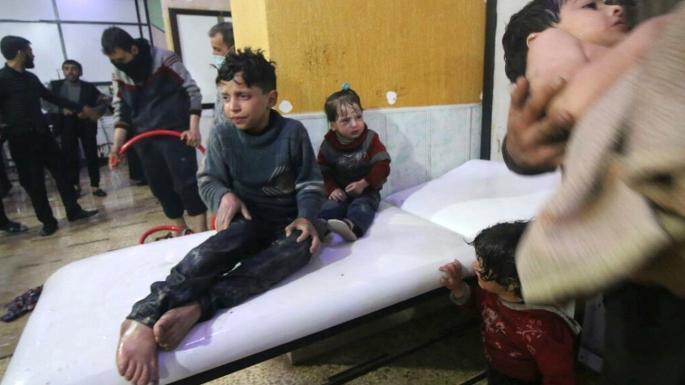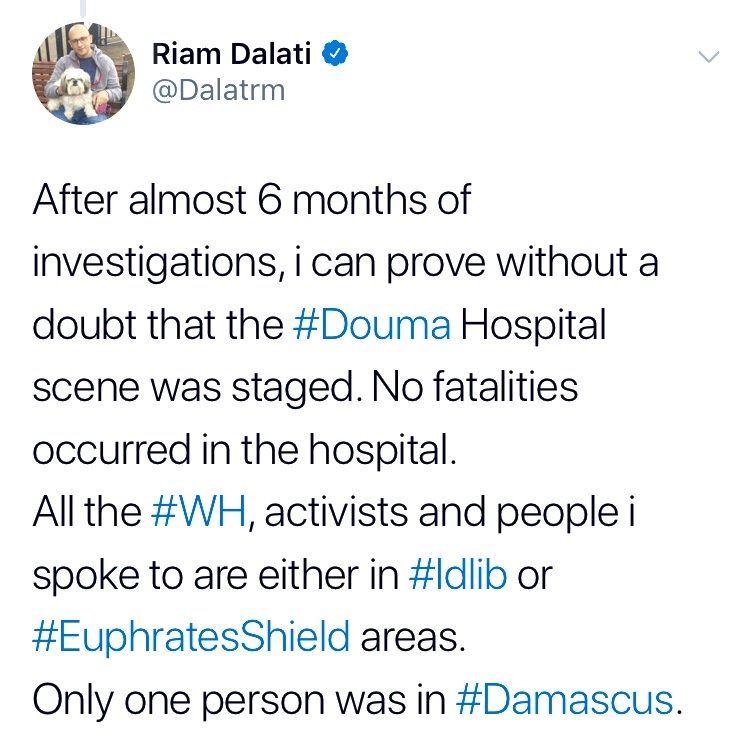BBC Producer’s Syria Bombshell: Douma “Gas Attack” Footage “Was Staged”

Now approaching nearly a year after the April 7, 2018 alleged chemical attack in Douma, Syria — which the White House used as a pretext to bomb Syrian government facilities and bases throughout Damascus — a BBC reporter who investigated the incident on the ground has issued public statements saying the “Assad sarin attack” on Douma was indeed “staged”.
Riam Dalati is a well-known BBC Syria producer who has long reported from the region. He shocked his nearly 20,000 twitter followers on Wednesday, which includes other mainstream journalists from major outlets, by stating that after a “six month investigation” he has concluded,
“I can prove without a doubt that the Douma Hospital scene was staged.”

One of many widely circulated images of the Douma hospital scene from April 2018. The Times (UK) published the image with the following headline: Syria attack: ‘We found bodies on the stairs. They didn’t see the gas in time’
The “hospital scene” is a reference to part of the horrid footage played over and over again on international networks showing children in a Douma hospital being hosed off and treated by doctors and White Helmets personnel as victims of the alleged chemical attack.
The BBC’s Dalati stated on Wednesday: “After almost 6 months of investigations, I can prove without a doubt that the Douma Hospital scene was staged. No fatalities occurred in the hospital.” He noted he had interviewed a number of White Helmets and opposition activists while reaching that conclusion.
He continued in a follow-up tweet:
Russia and at least one NATO country knew about what happened in the hospital. Documents were sent. However, no one knew what really happened at the flats apart from activists manipulating the scene there. This is why Russia focused solely on discrediting the hospital scene.
Dalati’s mention of activists at the flats “manipulating the scene there” is a reference to White Helmets and rebel activist produced footage purporting to show the deadly aftermath of a chemical attack inside a second scene — a bombed out apartment showing dozens of dead bodies.

The BBC’s Riam Dalati made his verified account private in the hours after the tweets.
Tragic and gruesome images of what appeared the “gassed” corpses of young children and women strewn about an apartment building, were recycled endlessly in mainstream media at the time, which the Trump administration referenced in its decision to strike Damascus with some 100 Tomahawk cruise missiles.
Dalati continued:
Truth is James Harkin got the basics right in terms of Douma’s “propaganda” value. The ATTACK DID HAPPEN, Sarin wasn’t used, but we’ll have to wait for OPCW to prove Chlorine or otherwise. However, everything else around the attack was manufactured for maximum effect.
The BBC producer added the following details as part of the thread:
I can tell you that Jaysh al-Islam ruled Douma with an iron fist. They coopted activists, doctors and humanitarians with fear and intimidation. In fact, one of the 3 or 4 people filming the scene was Dr. Abu Bakr Hanan, a “brute and shifty” doctor affiliated with Jaysh Al-Islam. The narrative was that “there weren’t enough drs” but here is one filming and not taking part of the rescue efforts. Will keep the rest for later.
A few hours after making the statements Dalati switched his verified Twitter account to “private”, likely after the Russian Embassy in the UK seized upon and began promoting the admission. A number of articles quickly appeared in Russian media as well.
.@BBC’s Syria producer @Dalatrm admits “Assad sarine attack in #Douma was staged”. Remarkable that British MSM chose to ignore it. No breaking news, no articles, nothing. pic.twitter.com/aAo7xq3nPQ— Russian Embassy, UK (@RussianEmbassy) February 14, 2019
The Russian Foreign Ministry weighed in on Thursday after the BBC producer’s admission, especially since it’s been Moscow’s position the whole time that the events surrounding the Douma attack were staged.
Russia’s TASS news agency cited ministry spokeswoman Maria Zakharova, who slammed the “theater of the absurd” connected to the April 7 events:
“The culmination of this theater of absurd may be a statement by a BBC producer who confirmed based on his own research that the footage [in Syria’s Douma] had been staged with direct participation of the White Helmets,” Zakharova said, noting that Russia wants to listen to the company’s position because it actively covered the events from the perspective of supporting the steps of the so-called US-led coalition in Syria.
Russia is now demanding that the BBC produce the results of its investigation for Moscow to review and evaluate.
The BBC’s Dalati made the statements in response to a lengthy investigative report by James Harkin writing for The Intercept. Harkin had examined the scenes and physical environs of the alleged Douma attack and interviewed eyewitnesses on site. His report paints a complex picture of propaganda and deeply compromised rebel sources such as Saudi-backed Jaish al Islam, which had control of Douma amidst a Syrian government onslaught to retake the town.
The “hospital scene” footage, now called “staged” by a BBC producer, circulated widely among media outlets at the time:
Harkin made mention of plausible early reports that the Douma victims had actually died of asphyxiation while hiding in an enclosed space or bunker due to repeat waves of conventional ordinance fired by the Syrian Army:
When it came to Douma, the Russians weren’t the only ones who were skeptical, at least initially, that chemical weapons had been used. The Syrian Observatory for Human Rights, a U.K.-based outfit that leans toward the opposition but whose reporting network inside the country is usually seen as most authoritative by the international media, noted the day after the attack that people had died in Douma through suffocation, but couldn’t say whether chemical weapons had been used.
The Intercept report also highlighted the fact that the Organization for the Prohibition of Chemical Weapons investigation flatly contradicted Washington’s claims that sarin had been used. Instead, “samples collected at both locations turned up ‘various chlorinated organic chemicals’ along with ‘the residues of explosive’ — not quite the same thing as saying that chlorine had been used as a chemical weapon…” according to the report.
Harkin further underscored that the OPCW’s on-site findings came as “something of a surprise” to analysts who had long parroted the early US and mainstream media claims of a confirmed chemical attack:
At least some of that caution appears to have been warranted. Three months after the attack, the OPCW released its interim report into what happened in Douma. The report found no evidence of organophosphorus nerve agents like sarin either at the site or in samples from the casualties — something of a surprise, because the suspected use of sarin had been one of the justifications for American airstrikes back in April, and alleged Syrian chemical weapons facilities their primary target. But the investigators did find something else.
Interestingly, the BBC’s Dalati had actually first hinted he knew that elements surrounding the Douma attack had been staged a mere days after the incident.
In a now deleted April 11, 2018 tweet, he had stated: “Sick and tired of activists and rebels using corpses of dead children to stage emotive scenes for Western consumption. Then they wonder why some serious journos are questioning part of the narrative.”
Thus far mainstream networks have not picked up on this latest bombshell admission from the BBC producer, but it will be interesting to see if there’s any formal response from the BBC based on the Russian foreign ministry’s request.
*
Note to readers: please click the share buttons below. Forward this article to your email lists. Crosspost on your blog site, internet forums. etc.
The original source of this article is Zero Hedge
Copyright © Zero Hedge, Zero Hedge, 2019
NRC:
Onderzoek NYT: Assad zit achter chemische aanval op Douma
Na eigen ‘forensisch’ onderzoek concludeert The New York Times dat Assad achter de gifgasaanval op Douma in april zit. Met Virtual Reality sta je ín het gebombardeerde gebouw.
Lisa Dupuy
26 juni 2018
Screenshot uit de video 'One Building, One Bomb: How Assad Gassed His Own People', waarin The New York Times verslag doet van zijn onderzoek naar het getroffen gebouw, het gebruikte chemische wapen en de dader van de gifgasaanval op Douma, afgelopen april.
Screenshot uit de video 'One Building, One Bomb: How Assad Gassed His Own People', waarin The New York Times verslag doet van zijn onderzoek naar het getroffen gebouw, het gebruikte chemische wapen en de dader van de gifgasaanval op Douma, afgelopen april.
The New York Times
Op 7 april 2018 vielen in één huis in Douma, destijds een belangrijke enclave voor rebellen in Syrië, minstens 34 doden. Bij het bombardement werd een bom met chloorgas ingezet. Door het Syrische regime, schrijft The New York Times in een artikel dat maandag is gepubliceerd. De Amerikaanse krant onderzocht het incident uitvoerig en maakte een multimediale productie.
Douma werd kort na de aanval ingenomen door Syrische overheidstroepen, de meeste journalisten werden weggestuurd. Wel verschenen er televisiereportages van Russische media. Volgens de NYT vertelden zij echter een “verdraaide versie” van het verhaal. Ook voor deze publicatie konden de NYT-journalisten niet ter plekke onderzoek doen. Maar dat hoeft ook niet om een gedegen analyse uit te voeren, zegt redacteur Malachy Browne in de video: “De Russische verslaggevers hebben ons, nietsvermoedend, met deze verslagen wél genoeg visueel materiaal verschaft voor ons digitale onderzoek naar de crime scene.”
Bekijk hier de video ‘One building, one bomb’ van The New York Times.
Technisch onderzoek
Dan volgt een uiteenzetting van wat ook wel digitaal ‘forensisch’ onderzoek kan worden genoemd: de journalisten legden social media-beelden, satellietfoto’s en de verslagen van ooggetuigen naast elkaar en reconstrueerden de getroffen locatie, de gebruikte bom en het tijdsverloop van de aanval (in die volgorde). Met uiteindelijk de conclusie: alle herhaalde ontkenningen van Assad en zijn medestanders ten spijt, zíjn regime zit achter de aanval op Douma.
Het is een technisch onderzoek waarbij meerdere experts aan het woord komen, maar door de visuele representatie wordt de verschrikking van de aanval invoelbaar gemaakt. Met hulp van virtual reality staat de kijker ín het getroffen gebouw. Op sommige momenten in de video zijn de beelden van slachtoffers vervaagd - té gruwelijk. Zo indrukwekkend als het graafwerk van dit redactionele team is, toch een aantekening die ook de voice-over aanhaalt: dit is maar één aanval, in een reeks van inzetten van chemische wapens, om niet te spreken over de duizenden bommen die in Douma en elders in Syrië al zijn neergedaald.
Wie mag deze conclusie eigenlijk trekken?
Dat het Assad-regime achter de aanval van 7 april zat, werd eerder ook al aangenomen door de Verenigde Staten en enkele Europese bondgenoten. De landen voerden bombardementen uit op doelwitten van het Syrische overheidsleger, ter vergelding voor het gebruik van chemische wapens.
In eerste instantie werd inspecteurs van de Organisatie voor het Verbod op Chemische Wapens (de OPCW) de toegang tot Douma ontzegd, volgens de Syrische en Russische overheden omdat hun veiligheid ter plekke niet kon worden gegarandeerd. Uiteindelijk kon toch een inspectie plaatsvinden in Douma. Het rapport daarvan wordt binnenkort afgerond. Het internationale orgaan mag alleen het gebruik van chemische wapens vaststellen. Het heeft geen mandaat om zich ook over de schuldvraag te buigen.
Over de vraag of die bevoegdheid moet worden uitgebreid, wordt dinsdag en woensdag in Den Haag gesproken tijdens een speciaal daarvoor belegde conferentie van de OPCW-lidstaten. Het Verenigd Koninkrijk heeft, na de gifgasaanvallen in Syrië én de Skripal-vergiftiging op het eigen grondgebied, daarvoor het initiatief genomen.
https://www.nrc.nl/nieuws/2018/06/26/de-gifgasaanval-op-douma-in-virtual-reality-a1608014


Geen opmerkingen:
Een reactie posten